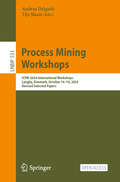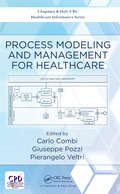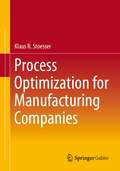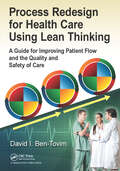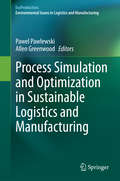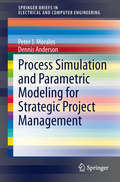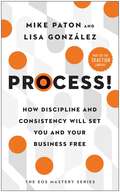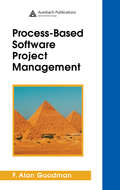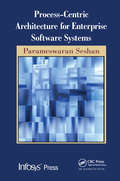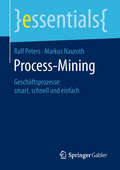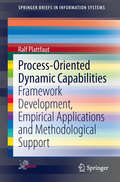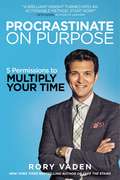- Table View
- List View
Process Mining Workshops: ICPM 2024 International Workshops, Lyngby, Denmark, October 14–18, 2024, Revised Selected Papers (Lecture Notes in Business Information Processing #533)
by Andrea Delgado Tijs SlaatsThis book constitutes the revised accepted papers of several workshops which were held in conjunction with the 6th International Conference on Process Mining, ICPM 2024, held in Lyngby, Denmark, during October 2024. The 56 revised full papers presented in this book were carefully reviewed and selected from 126 submissions. The papers presented in this volume stem from the following workshops: – 9th International Workshop on Process Querying, Manipulation, and Intelligence (PQMI) – 3rd International Workshop on Education Meets Process Mining (EduPM) – 3rd International Workshop on Collaboration Mining for Distributed Systems (CoMinDS) – 5th International Workshop on Leveraging Machine Learning in Process Mining (ML4PM) – 5th International Workshop on Event Data and Behavioral Analytics (EdbA) – 7th International Workshop on Process-Oriented Data Science for Healthcare (PODS4H) – 1st International Workshop on Empirical Research in Process Mining (ERPM) – 1st International Workshop on Generative Artificial Intelligence for Process Mining (GenAI4PM) – 4th International Workshop on Stream Management & Analytics for Process Mining (SMA4PM) – 1st International Workshop on Process Mining for Sustainability (PM4S).
Process Modeling and Management for Healthcare (Chapman & Hall/CRC Healthcare Informatics Series)
by Carlo Combi Giuseppe Pozzi Pierangelo VeltriFrom the Foreword: "[This book] provides a comprehensive overview of the fundamental concepts in healthcare process management as well as some advanced topics in the cutting-edge research of the closely related areas. This book is ideal for graduate students and practitioners who want to build the foundations and develop novel contributions in healthcare process modeling and management." --Christopher Yang, Drexel University Process modeling and process management are traversal disciplines which have earned more and more relevance over the last two decades. Several research areas are involved within these disciplines, including database systems, database management, information systems, ERP, operations research, formal languages, and logic. Process Modeling and Management for Healthcare provides the reader with an in-depth analysis of what process modeling and process management techniques can do in healthcare, the major challenges faced, and those challenges remaining to be faced. The book features contributions from leading authors in the field. The book is structured into two parts. Part one covers fundamentals and basic concepts in healthcare. It explores the architecture of a process management environment, the flexibility of a process model, and the compliance of a process model. It also features a real application domain of patients suffering from age-related macular degeneration. Part two of the book includes advanced topics from the leading frontiers of scientific research on process management and healthcare. This section of the book covers software metrics to measure features of the process model as a software artifact. It includes process analysis to discover the formal properties of the process model prior to deploying it in real application domains. Abnormal situations and exceptions, as well as temporal clinical guidelines, are also presented in depth Pro.
Process Monitoring and Fault Diagnosis Based on Multivariable Statistical Analysis (Engineering Applications of Computational Methods #19)
by Xiangyu Kong Jiayu Luo Xiaowei FengThis book reports the developments of the Total Least Square (TLS) algorithms for parameter estimation and adaptive filtering. Specifically, this book introduces the authors’ latest achievements in the past 20 years, including the recursive TLS algorithms, the approximate inverse power iteration TLS algorithm, the neural based MCA algorithm, the neural based SVD algorithm, the neural based TLS algorithm, the TLS algorithms under non-Gaussian noises, performance analysis methods of TLS algorithms, etc. In order to faster the understanding and mastering of the new methods provided by this book for readers, before presenting each new method in each chapter, a specialized section is provided to review the closely related several basis models. Throughout the book, large of procedure of new methods are provided, and all new algorithms or methods proposed by us are tested and verified by numerical simulations or actual engineering applications. Readers will find illustrative demonstration examples on a range of industrial processes to study. Readers will find out the present deficiency and recent developments of the TLS parameter estimation fields, and learn from the the authors’ latest achievements or new methods around the practical industrial needs. In my opinion, this book can be assimilated by advanced undergraduates and graduate (PH.D.) students, as well as statisticians, because of the new tools in data analysis, applied mathematics experts, because of the novel theories and techniques that we propose, engineers, above all for the applications in control, system identification, computer vision, and signal processing.
Process Optimization for Manufacturing Companies
by Klaus R. StoesserErfahren Sie in diesem Buch über Prozessoptimierung für produzierende Unternehmen alles über die neue Methode LEO-3DIn seinem Buch „Prozessoptimierung für produzierende Unternehmen“ beschreibt Klaus R. Stoesser einen neuen, kombinierten Ansatz, mit dem Firmen aus dem produzierenden Gewerbe ihre Geschäftsprozesse optimieren können. Der Autor stellt hierfür Philosophien wie Lean Management, Six Sigma und SCRUM vor. Darauf aufbauend führt er seine eigens entwickelte Philosophie LEO-3D ein, welche Unternehmen vielseitige Möglichkeiten bietet.Der Inhalt im ÜberblickIm Kern geht es in Stoessers Buch über Prozessoptimierung für produzierende Unternehmen um folgende Themen:• Entwicklung der Prozessoptimierung• LEO-3D• Ausgewählte Methoden, Tools und VorgehensweisenEs vermittelt diese Ansätze, um Prozesse in Unternehmen ganzheitlich im zu verbessern und damit das Ergebnis nachhaltig zu steigern.
Process Oriented Analysis: Design and Optimization of Industrial Production Systems
by Urs B. Meyer Simone E. Creux Andrea K. Weber MarinIn modern manufacturing, it is not simply the equipment that is increasingly complex but rather the entire business system in which a company operates. Convoluted supply chains, complicated resource flows, advanced information systems: all must be taken into account when designing or reengineering a manufacturing system. Introducing a powerful yet
Process Redesign for Health Care Using Lean Thinking: A Guide for Improving Patient Flow and the Quality and Safety of Care
by David I. Ben-TovimProcess Redesign for Health Care Using Lean Thinking is a response to a simple, but hard to answer, question and is the result of the experiences of a working doctor who was also the chief safety and quality officer of an Australian teaching hospital. At this hospital, he observed that the Emergency Department was staff by talented, well-trained, and respected doctors and nurses. The facilities were modern, and the work load unexceptional, but the department was close to melt down. Bad things were happening to patients, everyone was blaming each other, lots of things had been tried but nothing was getting better and no one could explain why. The problem was not a lack of technical knowledge or expertise, the problem was that no one stood back and said, "what’s the best way to move 200 or 300 patients a day through the complicated and varying, sequence of steps needed to sort out the many different problems that bring patients to our department?" These challenges are faced by hospitals and health services all over the world. There are difficulties with patient flow, congestion, queues, inefficient utilization of resources, problems engaging clinical staff in improvement programs, adverse incidents, and budget constraints. Lean thinking and value stream analysis gives hospitals and health services struggling with these issues the insights they need to help themselves. This book provides a method that systematically turns those insights into working programs of service and system redesign. The book is divided into two sections. The first section gives the background to the approach, and systematically works through the Process Redesign methodology, step-by-step. The second section is a series of case studies that show the methodology in action, what worked and what didn’t work. The goal of any process redesign is simple: the right care, for the right person, at the right time, in the right place, and right the first time. This book helps the people who work in hospitals and health services realize these goals by working together.
Process Simulation and Optimization in Sustainable Logistics and Manufacturing
by Pawel Pawlewski Allen GreenwoodThe aim of this book is to present qualitative aspects of logistics operations and supply chain management which help to implement the sustainable policy principles in the companies and public sector's institutions. Authors in individual chapters address the issues related to reverse network configuration, forward and reverse supply chain integration, CO2 reduction in transportation, improvement of the production operations and management of the recovery activities. Some best practices from different countries and industries are presented. This book will be valuable to both academics and practitioners wishing to deepen their knowledge in the field of logistics operations and management with regard to sustainability issues.
Process Simulation and Parametric Modeling for Strategic Project Management
by Dennis Anderson Peter J. MoralesProcess Simulation and Parametric Modeling for Strategic Project Management will offer CIOs, CTOs and Software Development Managers, IT Graduate Students an introduction to a set of technologies that will help them understand how to better plan software development projects, manage risk and have better insight into the complexities of the software development process. A novel methodology will be introduced that allows a software development manager to better plan and access risks in the early planning of a project. By providing a better model for early software development estimation and software development, managers will be better equipped to make more effective project portfolio investment choices. Moreover, the methodology will allow the software development manager to continually simulate scenarios throughout the lifecycle of the project and determine plausible alternatives before the risk becomes a reality.
Process of Going Public in the United States
by Gregory S. MillerSummarizes the process of going public: the steps for SEC approval, the role of the SEC, and the roles of major players such as underwriters and printers.
Process of Strategy Definition and Implementation
by Clayton M. Christensen Jeremy B. DannStrategy definition is not a short, discrete process. Rather, outside influences (market, political, technological, etc.) and the company's own resource allocation process continually reshape an organization's strategy.
Process!: How Discipline and Consistency Will Set You and Your Business Free (The EOS Mastery Series)
by Mike Paton Lisa GonzálezThis deep-dive into the revolutionary EOS method to strengthen a company&’s process component will help leaders at all companies—from early stage startups to established corporations—run better businesses and live better lives. Part of the TRACTION Library, Process! proves that a high-level, 20/80 approach to getting your core processes &“followed by all&” will help you: Get consistently exceptional results Improve and innovate as necessary Free yourself to live your ideal life If you own, run, or lead in a fast-moving business, you&’re likely driven by passion and a desire to be free. Many leaders mistakenly believe instilling rigor and discipline for process throughout your organizations will inhibit freedom. They couldn&’t be more wrong. It&’s when you&’re stuck in the day-to-day, putting out fires and cleaning up messes, that passion turns to frustration. Freedom seems somewhere between elusive and impossible. The secret to getting unstuck is process. This inspiring, informative field guide will prove it&’s possible to establish rigor and discipline for process while also increasing creativity, flexibility, and innovation. Process! will help you identify a handful of core processes that make your business uniquely valuable. You&’ll learn how to document and simplify the major steps in those processes so they can be done the right and best way, every time. Finally, you&’ll execute a simple, step-by-step plan that is helping more than 10,000 entrepreneurs around the world consistently get the results they want.
Process-Based Software Project Management
by F. Alan GoodmanNot connecting software project management (SPM) to actual, real-world development processes can lead to a complete divorcing of SPM to software engineering that can undermine any successful software project. By explaining how a layered process architectural model improves operational efficiency, Process-Based Software Project Management out
Process-Centric Architecture for Enterprise Software Systems
by Parameswaran SeshanThe increasing adoption of Business Process Management (BPM) has inspired pioneering software architects and developers to effectively leverage BPM-based software and process-centric architecture (PCA) to create software systems that enable essential business processes. Reflecting this emerging trend and evolving field, Process-Centric Architecture for Enterprise Software Systems provides a complete and accessible introduction explaining this architecture. The text presents, in detail, the analysis and design principles used in process-centric architecture. Illustrative examples demonstrate how to architect and design enterprise systems based on the business processes central to your organization. It covers the architectural aspects of business process management, the evolution of IT systems in enterprises, the importance of a business process focus, the role of workflows, business rules, enterprise application integration, and business process modeling languages such as WS-BPEL and BPML. It also investigates: Fundamental concepts of process-centric architecture style The PCA approach to architecting enterprise IT systems Business process driven applications and integration Two case studies that illustrate how to architect and design enterprise applications based on PCA SOA in the context of process-centric architecture Standards, technologies, and infrastructure behind PCA Explaining how to architect enterprise systems using a BPMS technology platform, J2EE components, and Web services, this forward-looking book will empower you to create systems centered on business processes and make today's enterprise processes successful and agile.
Process-Driven Applications with BPMN
by Volker StiehlHow can we optimize differentiating business processes and exploit their full potential? Here Volker Stiehl provides answers, utilizing the various options that the BPMN (Business Process Model and Notation) standard offers for planning, implementing and monitoring processes. The book presents an approach for implementing an architecture for applications that strives to find a balance between development and maintenance costs, sustainability, scalability and fault tolerance; that meets flexibility requirements without becoming inordinately complex itself; and that keeps the end application as abstract as possible from the system landscape in which it operates. Based on the semantic enhancements found in version 2. 0 of the BPMN standard, which have made it possible to execute process models, his approach exploits BPMN to create and run complete application architectures. In this context, BPMN is not just used to model the business processes of the application, as the "B" in BPMN might suggest; but also to model and execute the integration processes between the systems. Throughout the book, the software package SAP Process Orchestration is used to illustrate the implementation of the proposed architecture, yet all recommendations are intentionally kept generic so that they can be implemented on any other comparable platform as well. Software architects, IT managers, software developers and project managers, as well as students of information and business technology will find the book a valuable resource. The proposed application architecture offers them a detailed blueprint, the principles of which they can use to plan and implement process-driven distributed applications.
Process-Mining: Geschäftsprozesse: smart, schnell und einfach (essentials)
by Ralf Peters Markus NaurothDie Autoren geben einen praxisorientierten Einstieg in Process-Mining mit unternehmensbezogenen Anwendungsfällen und einer Marktübersicht der Software, die hilft, Geschäftsprozesse schnell, smart und einfach zu gestalten. Auf Basis von Log-Daten der Geschäftsvorgänge erstellt Process-Mining automatisch Modelle der Ist-Abläufe, kann diese mit Soll-Abläufen vergleichen und helfen, Geschäftsprozesse zu optimieren. Weitere Anwendungen von Process-Mining sind u.a. Governance, Risk und Compliance Management, IT-Migration und -Implementierung sowie Entwicklung digitaler Geschäftsmodelle. Process-Mining ist gerade auch für kleinere und mittelgroße Unternehmen von großer Bedeutung für die Wettbewerbsfähigkeit.Die Autoren Ralf Peters ist selbstständiger Unternehmensberater und Interimsmanager. Er unterstützt Unternehmen in Transformationsphasen, bei Post-Merger-Integrationen, IT-Implementierungen sowie dem Einsatz von Process-Mining. Prof. Dr. Markus Nauroth lehrt Wirtschaftsinformatik an der Hochschule Mainz und verantwortet u.a. als Studiengangleiter den Bachelor-Studiengang Angewandte Informatik. Zuvor war er als Unternehmensberater in London und New York tätig.
Process-Oriented Dynamic Capabilities
by Ralf PlattfautThis book introduces a process-oriented dynamic capability framework to study both, service innovation and Business Process Management (BPM). Results from applications in several case studies and surveys are reported. They reflect, e. g. , capability development and maturity models. Based on these findings, a method to support service innovation is introduced. This method can help organizations in developing new service business models in a more effective and efficient way. In today's networked service society, service innovation becomes increasingly important. Reasons for this development can be found in the transformation of economies and in the growing importance of product-service systems. The concept of service innovation is related to Business Process Management (BPM) and shares several important traits. They both are process-oriented dynamic capabilities to adapt (service) processes to changing environments.
Processes and Production Methods (PPMs) in WTO Law
by Christiane R. ConradDespite a decades-long debate, starting with the 'Tuna-Dolphin' disputes of the 1990s, questions on the status of national regulatory measures linked to processes and production methods in WTO law have yet remained unsolved. Likewise, labelling requirements relating to unincorporated aspects of a product's life cycle remain strongly contested. These ongoing disputes at the WTO as well as global social and environmental challenges related to economic activities show how topical and important the search for adequate answers still is. Processes and Production Methods (PPMs) in WTO Law identifies and comprehensively analyses the key legal problems concerning such measures, setting them in the context of the current debate and its economic and regulatory background. Christiane R. Conrad develops a new approach to this debate which draws on the objectives and established economic rationales of the WTO Agreements.
Processing Vehicles Used in Violent Crimes for Forensic Evidence
by Christopher D. DuncanWhile there are numerous books on crime scene investigation and the processing of crime scenes, few focus on the processing of vehicles. Whether the crime took place in the car or the car was used to transport the suspect or victim—and, as such, is a secondary scene—investigating vehicles presents several unique challenges. Processing Vehicles Used in Violent Crimes for Forensic Evidence fills this void providing the technical instruction sorely needed in this area of crime scene investigation. The book is geared not only to investigators who process vehicles involved in general crimes but also with a specific focus on violent crimes. Coverage includes details as to how investigators should document the vehicle in a logical and methodical manner that is easily understood and replicated for various scenes. By identifying the unique challenges caused by working in the tight quarters of a vehicle—especially in photographing the vehicle, the evidence within it, and how to best find, collect, document, and preserve the evidence—the author provides a unique reference for investigators. Special attention is paid to documenting shooting incidents, the proper detailing and documentation of bullet trajectories, bloodstain documentation, and processing vehicles for other biological, impression, and physical evidence. Key Features Presents crime scene collection and preservation techniques and methodology specific to vehicle-related considerations Outlines the unique challenges, and step-by-step procedural requirements, necessary to conduct a vehicle or vehicle-related scene investigation Addresses types of various evidence for vehicles—including fingerprint, blood, DNA, bullet and casing, and fire debris—which are common primary or secondary crime scenes While the book is geared toward crime scene investigators and forensic technicians who process vehicles used in crimes, it will be an invaluable resource for criminal justice and forensic science students, attorneys, death investigators, fire investigators, accident scene investigators, and scene reconstructionists.
Procrastinate on Purpose
by Rory VadenFrom the New York Times bestselling author of Take the Stairs--a bold new way to get things done. New York Times bestselling author and sales-performance trainer Rory Vaden brings his high-energy approach and can-do spirit to the most nagging problem in our professional lives: stalled productivity. Millions are overworked, organizationally challenged, or have a motivation issue that's holding them back. Vaden presents a simple yet powerful paradigm that will set readers free to do their best work--on time and without stress and anxiety.
Procter & Gamble
by Jay W. Lorsch Kathleen DuranteOn July 12, 2012, Bill Ackman's Pershing Square Capital Management announced publicly that it had purchased about $2 billion of Procter and Gamble (P&G) stock. Shares in the company closed up 3.75% the day the disclosure was made public. Ackman told the New York Times that Pershing would be a major P&G shareholder. ""We think it's an underrated stock,"" he said. ""We think there is a lot of great opportunity there."" During the next several months there was little or no public discussion of the matter although people familiar with the situation reported that Ackman held conversations with P&G directors individually. Then, on April 24, 2013, P&G announced that its 3rd quarter earnings had risen 6%. However its 4th quarter forecast fell short of Wall Street's expectations. Shares fell 5% based on this outlook. P&G results were lagging its peers by 4% in 2012 and 2% in the first quarter of 2013. Then, abruptly in late May, CEO Robert A. McDonald, who was 59, resigned. The board selected A.J. Lafley, (65) who had been McDonald's predecessor to return to lead the company. There was speculation about how long Lafley would stay and in what direction he would take the company. On June 6th, P&G announced that Lafley had appointed four senior executives to lead the company's major businesses, reporting directly to him.
Procter & Gamble
by Jay W. Lorsch Kathleen DuranteOn July 12, 2012, Bill Ackman's Pershing Square Capital Management announced publicly that it had purchased about $2 billion of Procter and Gamble (P&G) stock. Shares in the company closed up 3.75% the day the disclosure was made public. Ackman told the New York Times that Pershing would be a major P&G shareholder. ""We think it's an underrated stock,"" he said. ""We think there is a lot of great opportunity there."" During the next several months there was little or no public discussion of the matter although people familiar with the situation reported that Ackman held conversations with P&G directors individually. Then, on April 24, 2013, P&G announced that its 3rd quarter earnings had risen 6%. However its 4th quarter forecast fell short of Wall Street's expectations. Shares fell 5% based on this outlook. P&G results were lagging its peers by 4% in 2012 and 2% in the first quarter of 2013. Then, abruptly in late May, CEO Robert A. McDonald, who was 59, resigned. The board selected A.J. Lafley, (65) who had been McDonald's predecessor to return to lead the company. There was speculation about how long Lafley would stay and in what direction he would take the company. On June 6th, P&G announced that Lafley had appointed four senior executives to lead the company's major businesses, reporting directly to him.
Procter & Gamble (B): Turning to Success
by Rosabeth Moss Kanter Matthew BirdSupplements with the (A) Case.
Procter & Gamble 2000 (A): The SpinBrush and Innovation at P&G
by William A. Sahlman R. Matthew WillisDescribes a set of decisions confronting some managers in the oral care division of Procter & Gamble. They must decide whether to buy a company that has developed an inexpensive, battery-operated toothbrush. The company's product has done well in one market, but determining an appropriate value and structure is challenging.
Procter & Gamble Brazil (A): 2 1/2 Turnarounds
by Rosabeth Moss Kanter Matthew BirdJuliana Azevedo Schahin, a local marketing director for Procter & Gamble in Sao Paulo, had worked closely with Tarek Fahahat, a regional executive based in Caracas, to solve the growth and profitability problems of P&G Brazil. They did so through the creation of lower-cost versions of two premium products which reached BOP (bottom of the pyramid) consumers--an approach not considered then as a company strategy. The case follows Azevedo and Farahat through their steps in helping to conceive the change, sell it to senior management, and implement it. The true test comes when the subsidiary wants to extend the model to its third and largest category, laundry care, which had also struggled. But Azevedo did not oversee that business in Brazil, and Farahat worked in another category in Caracas. Her country colleagues go to her to learn more about the success of the first two products. Now the question is whether this is a one-time wonder or an innovation that should be diffused to other products and geographies.
Procter & Gamble Brazil (A): 2 1/2 Turnarounds
by Rosabeth Moss Kanter Matthew BirdJuliana Azevedo Schahin, a local marketing director for Procter & Gamble in Sao Paulo, had worked closely with Tarek Fahahat, a regional executive based in Caracas, to solve the growth and profitability problems of P&G Brazil. They did so through the creation of lower-cost versions of two premium products which reached BOP (bottom of the pyramid) consumers--an approach not considered then as a company strategy. The case follows Azevedo and Farahat through their steps in helping to conceive the change, sell it to senior management, and implement it. The true test comes when the subsidiary wants to extend the model to its third and largest category, laundry care, which had also struggled. But Azevedo did not oversee that business in Brazil, and Farahat worked in another category in Caracas. Her country colleagues go to her to learn more about the success of the first two products. Now the question is whether this is a one-time wonder or an innovation that should be diffused to other products and geographies.
